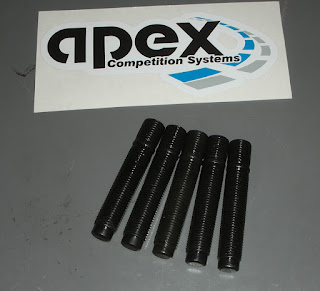

As an authorized H&R dealer, we have a full selection of wheel spacers from 7 to 45mm available to us. The goal was to widen the track to the width of a GT3 keeping the various tires sizes and wheel width options in mind.
We started with a 14mm H&R spacer which we trial fitted to both the front and the rear. Some have used a narrower 7mm spacer at the front of the 996 so we were hesitent to immediately put 14mm spacers on all 4 corners. However after testing the 14mm at all for corners and checking the clearances we determined this was well within fender. This also maintained the factory's original front to rear track difference and brought the tire out to about the same position it would be had we installed a set of wider and deeper offset GT3 wheels.

In the rear we determined that a slightly wider spacer could be used due to the additional fender clearance. So for our final setup we selected a 14mm spacer for the front and a 15mm spacer for the rear. An 18mm spacer could also have been used at the rear however we made a concession to the width as this car would also be regularly street driven. The concern was that 18mm would cause dirt and water coming off the wheel to splash down the side of the bodywork.

Any spacer for the Porsche 996 is going to require either longer wheel bolts or a conversion to a a stud & nut kit such as our "Track Stud" conversion kits. The first thing you need to do is determine what type of wheel nuts you will need. This will be determined by the type of wheels you have. If you have factory Porsche wheels you will need spherical seat wheel nuts such as those found on earlier Porsches. However if you have aftermarket wheels they often use a conical seat and you will therefore need a wheel nut with a matching 60 degree cone seat.

If you change your wheels often like we do then on of our ACS "Track Stud" wheel stud kits will make your lfe much easier. In addition to the extra strength affored you by these kits, repeatedly mounting a heavy wheel/tire combo become a "peice of cake". No more balancing the wheel on your foot while you struggle to thread that first wheel bolt in.















